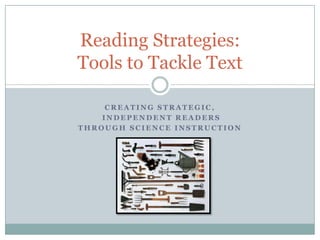
Reading strategies for science final
- 1. Creating strategic, independent readers Through Science instruction Reading Strategies:Tools to Tackle Text
- 2. Research on Reading Strategy Instruction Research has demonstrated that the teaching of reading strategies is most effective when “students are engaged in reading challenging, content-rich texts. Such skills don’t stick when practiced for their own sake. Rather, students learn those skills best when they have compelling reasons to use them” (Heller & Greenleaf, 2007, p. 8).
- 3. Research on Cross-Curricular Connections Ogle and Lang’s (2007) review of the research suggests that it is even more powerful if school teams work together across content areas to create a shared set of strategies and common vocabulary that students can have practice with strategies in multiple contexts across the school day. (The goods being student achievement)
- 4. More Research: Making It Content Specific Content area teachers “should also understand what is distinct about reading and writing in their own discipline, and how to make those rules, conventions, and skills apparent to students. If students are to succeed in the content areas, teachers will need to demystify the reading and writing that go on there, putting those things out on the table for everyone to see and discuss” (Heller & Greenleaf, 2007).
- 5. Turn and Talk What makes reading in science/health different from reading in other subject areas?
- 6. Science reading is unique because…
- 7. Quality Reading Activities= Content Learning In addition, as shown in the research around collaborative strategic reading, students learn at least as much content when engaged in high-quality reading activities as other types of activities. Thus, there isn’t any content learning cost associated with increasing the amount of time students spend reading, and it allows students to develop their reading proficiencies.
- 8. What’s Next? We already have a shared SMART framework, but there is more we can do to be in unified in supporting our students. We can: Identify strategies that are being used in English and Scholar Hour that can be used in science as well to have a positive impact on student’s science/health comprehension Determine the unique ways these strategies would be used in the context of science/health
- 9. Scholar Hour and English Reading Strategies SWBAT… Make meaningful text to text, text to self, and text to world connections and use the connection to better understand what they read. Visualize the text. Make predictions about outcomes using evidence and prior knowledge. Draw inferences and conclusions using textual evidence and prior knowledge. Create questions about text that reflect HOTS. Summarize text. Monitor for comprehension. Chunk the text when reading. Use fix up strategies (rereading, slowing down, stopping to jot ideas, etc.) when understanding breaks down.
- 10. Good Readers Monitor for Comprehension “Strategic learning during reading is all about monitoring reading and making sense. Skilled readers know how to monitor and keep track of whether the author is making sense…” --Vacca, 2002 Monitoring for comprehension is especially important when students are dealing with the complicated texts that are often present in content area classes. This is one of the most important reading proficiencies we can help develop in our students.
- 11. Not Just Going through the Motions How does this comic connect to what we see in how some of our students code text?
- 12. One Powerful Shared Strategy: Teaching Students to Monitor for Comprehension How do we help our students monitor their comprehension? We can teach students: To chunk the text by breaking it into smaller pieces (like at the end of each paragraph). To stop and check their understanding at the end of each chunk and reread if necessary. To code and annotate the text to increase understanding. The annotations can include “passage mapping” by jotting the main idea of each paragraph in the margin.
- 13. Let’s Try It Chunking text (breaking it down to smaller pieces) Monitoring for comprehension and fix-up strategies Annotations including coding and passage mapping
- 14. Making It Visible Modeling using think-alouds is a great way to make the content-specific reading and writing demands of science clear for students. Thinking aloud while modeling by the teacher provides learners with a way to observe “expert thinking” usually hidden from the student (Rosenshine and Meister, 1993).
- 15. Think-Aloud Research Think-alouds are highly effective in helping students: master a broad range of strategies to enhance understanding of text develop an ability to monitor their reading comprehension employ fix-up strategies when they detect comprehension difficulties (Baumann, Seifert-Kessell, & Jones, 1992)
- 16. The Neuroscience Behind the Research Read “Mirrors and Models” gathering evidence to answer this question: Why is it important that we model and do think-alouds for students in our classes?
- 17. Research on Handing Over Responsibility Ogle and Lang (2007) recommend that reading strategy lessons: Show students how to do the strategy Provide support for students in trying the strategy Provide chances for independent practice so students can make it their own This is a repeating cycle as teachers refine teaching points based on their students’ needs.
- 18. Planning a Think Aloud Plan a think-aloud that you could do for your class that includes chunking text, monitoring for comprehension, fix-up strategies, and annotating to increase understanding.